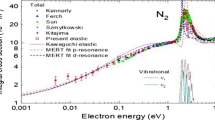Abstract
Theoretical and experimental aspects of the production, transformation, diffusion and loss of N2 in the upper atmosphere are considered. The N2-CO2 near-resonant system in theD andE regions is taken into account. We describe our understanding of the methods necessary to find the vibrational populations of N2 and CO2 (asymmetric mode of CO2). The calculations of the vibrational temperatures in theD, E, andF regions for the mid-latitude ionosphere and an aurora are presented. The connection between the excited species and the 4.26-μm radiation intensities is considered. The models for the rate coefficient of the reaction of O+ with N2 and the electron density decrease resulting from N2 in the F region are discussed.
Similar content being viewed by others
References
Albritton, D. L., Dotan, I., Lindinger, W., McFarland, M., Tellinhuisen, J. andFehsenfeld, F. C. (1977).Effects of ion speed distributions in flow-drift tube studies of ion-neutral reactions, J. Chem. Phys.66, 410–421.
Fujimoto, G., Nitzan, A. andWeltz, E. (1976),Diffusion of vibrationally excited molecules. J. Chem. Phys.15, 217–225.
Gilmore, F., Bones, E. andMcGowan, J. (1969),A review of atomic and molecular excitation mechanisms in nonequilibrium gases up to 2000 K. J. Quantitative Spectroscopy and Radiative Transfer9, 157–183.
Gordiets, B. F., Osipov, A. I. andSchelepin, L. A. The kinetic processes in gases and molecular lasers. (Nauka, Moscow 1980).
Haddad, G. N. (1984),Cross-sections for electron scattering in nitrogen. Aust. J. Phys.37, 487–494.
Hedin, A. E. (1983),A revised thermospheric model based on mass spectrometer and incoherent scatter data: MSIS-83. J. Geophys. Res.88, 10170–10188.
Lee, J. H., Michael, J. V., Payne, W. A. andStief, L. J. (1978),Absolute rate of the reaction of N( 4 S) with NO from 196–400 K with DF-RF and FP-RF techniques. J. Chem. Phys.69, 3069–3073.
McFarland, M., Albritton, D. L., Fehsenfeld, F. C., Ferguson, E. E., andSchmeltekopf, A. L. (1973),Flow-drift technique for ion mobility and ion-molecule reaction rate constant measurements, II. Positive ion reactions of N +,O +,and N 2 + with O 2 and O + with N 2 from thermal to 2 eV. J. Chem. Phys.59, 6620–6628.
McNeal, R. J., Whitson, M. E. andCook, G. R. (1974),Temperature dependence of the quenching of vibrationally excited nitrogen by atomic oxygen. J. Geophys. Res.79, 1527–1531.
Newton, G. P., Walker, J. C. G. andMeijer, P. H. E. (1974),Vibrationally excited nitrogen in stable auroral red arcs and its effect on ionospheric recombination. J. Geophys. Res.79, 3807–3818.
Pavlov, A. V. (1981),The binary molecular diffusion coefficient of the neutral components of the upper atmospheres of earth. Mars and Venus (in Russian). Kosmicheskie issledovanij,19, 82–86.
Pavlov, A. V. (1985),The method of calculation of the vibrationally excited nitrogen effect on the composition of the ionosphere (in Russian). Preprint N76(609), (IZMIRAN, Moscow, 1985).
Pavlov, A. V. (1986),Rate coefficient for the reaction of O + with vibrationally excited N 2 in the ionosphere (in Russian). Geomagnetism and Aeronomy26, 152–154.
Pavlov, A. V., (1986),The cooling rate of thermal electrons by vibrational excitation of N 2 (in Russian). Geomagnetism and Aeronomy26, 669–670.
Pavlov, A. V. (1986),The vibrational relaxation of N 2,CO 2 at altitudes of the E and D regions (in Russian). Preprint N69(683), (IZMIRAN, Moscow, 1986).
Richards, P. G. andTorr, D. G. (1985),Seasonal, diurnal, and solar cyclical variations of the limiting H + flux in the Earth's topside ionosphere. J. Geophys. Res.90, 5261–5268.
Richards, P. G., Torr, D. G. andAbdou, W. A. (1986),Effects of vibrational enhancement of N 2 on the cooling rate of ionospheric thermal electrons. J. Geophys. Res.91, 304–310.
Scharp, W. E., Rees, M. H. andStewart, A. I. (1979),Coordinated rocket and satellite measurements of an auroral event. 2. The rocket observations and analysis. J. Geophys. Res.84, 1977–1985.
Schulz, G. J.,A review of vibrational excitation of molecules by electron impact at low energies, in principles of laser plasmas (ed. G. Berkefi) (John Wiley, New York (1976), pp., 33–76.
Schmeltekopf, A. L., Ferguson, E. E. andFehsenfeld, F. C. (1968),Afterglow studies of the reactions He +;He(23S),and O + with vibrationally excited N 2. J. Chem. Phys.48, 2966–2973.
Streit, G. E., Howard, C. J., Schmeltekopf, A. L., Davidson, J. A. andSchiff, H. I. (1976),Temperature dependence of O(1 D) rate constants for reactions with O 2,N 2,CO 2,O 3 and H 2 O. J. Chem. Phys.65, 4761–4764.
St.-Maurice, J. P. andTorr, D. G. (1978),Nonthermal rate coefficients in the ionosphere: The reactions of O + with N 2,O 2 and NO. J. Geophys. Res.83, 969–977.
Suchkov, A. Ph. andSchebeko, J. N. (1981),The kinetic of the vibrational exchange in the nonequilibrium nitrogen (in Russian). Chimija vasokich energij15, 279–283.
Tohmatsu, T. andYamamoto, H. (1976),Radiative transfer of atomic and molecular resonant emissions in the upper atmosphere, 1. Basic theories in Doppler-broadening atmospheres. J. Geomagn. Geoelectr.28, 437–460.
Torr, M. R., Torr, P. G. (1982),The role of metastable species in the thermosphere. Rev. Geophys. Space Phys.20, 91–144.
Tully, J. C. (1974),Collision complex model for spin forbidden reactions: quenching of O(1 D) by N 2 J. Chem. Phys.61, 61–68.
Van Zandt, T. E. andO'Malley, T. F. (1973),Rate coefficient for the reaction of O + with vibrationally excited N 2 J. Geophys. Res.28, 6818–6820.
Viehland, L. A. andMason, E. A. (1977),Statistical-mechanical theory of gaseous ion-molecule reactions in an electrostatic field. J. Chem. Phys.66, 422–434.
Waite, J. H., Nagy, A. F. andTorr, D. G. (1979),N 2 vibrational distribution in aurorae. Planet. Space Sci.27, 901–903.
Vlaskov, V. A. andHenriksen, K. (1985),Vibrational temperature and excess vibrational energy of molecular nitrogen in the ground state derived from N 2 + emission bands in Aurora. Planet. Space Sci.33, 141–145.
Author information
Authors and Affiliations
Rights and permissions
About this article
Cite this article
Pavlov, A.V. The role of vibrationally excited nitrogen in the ionosphere. PAGEOPH 127, 529–544 (1988). https://doi.org/10.1007/BF00879824
Received:
Revised:
Accepted:
Issue Date:
DOI: https://doi.org/10.1007/BF00879824




